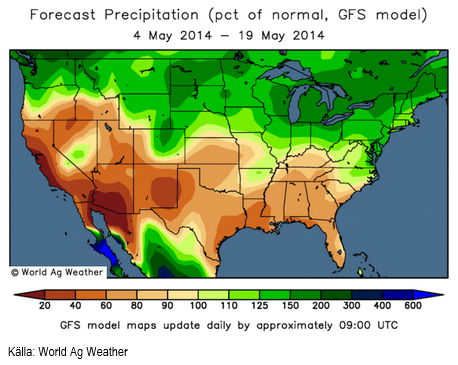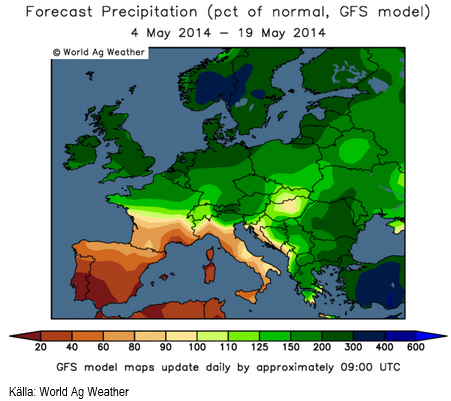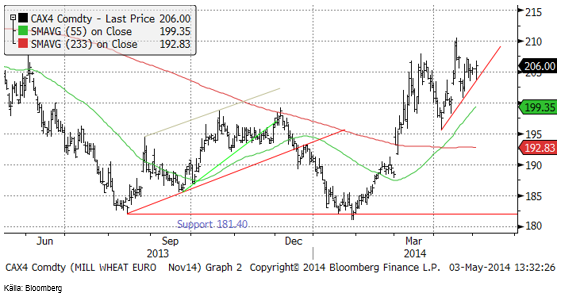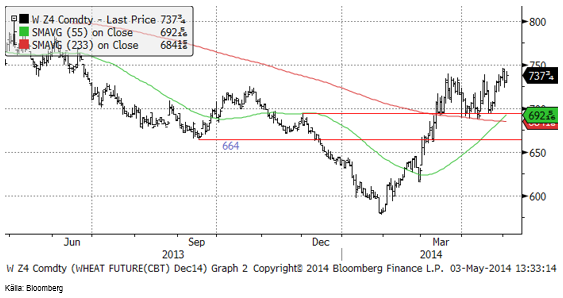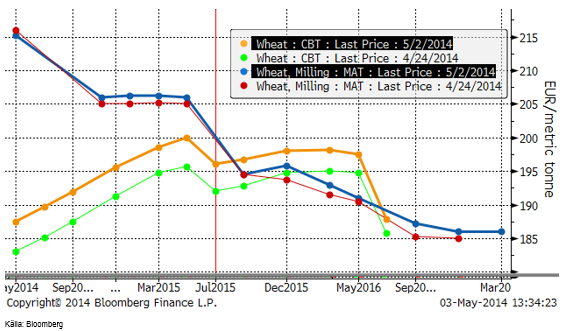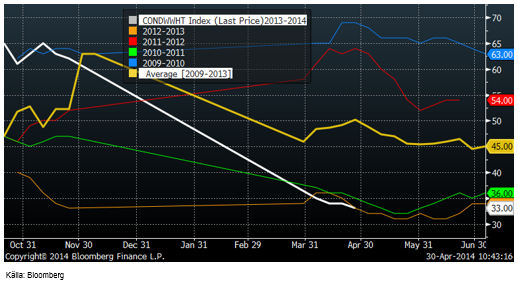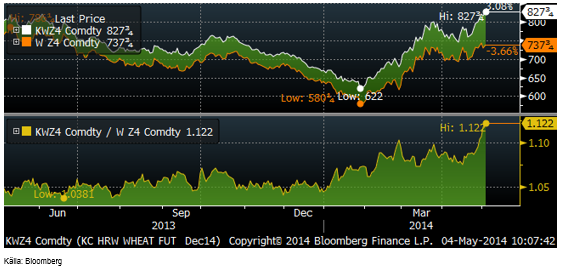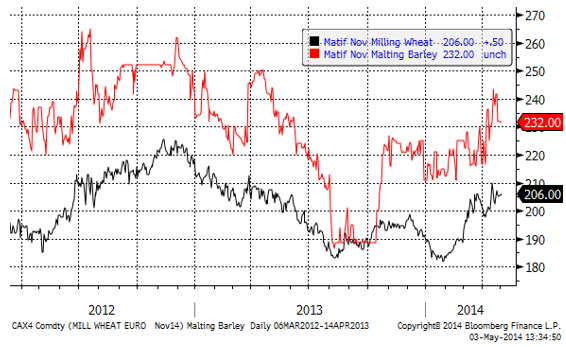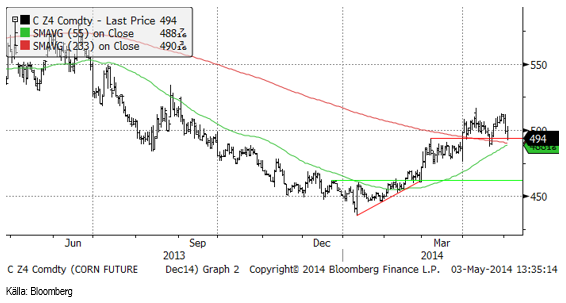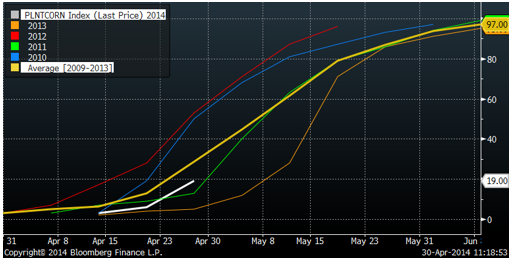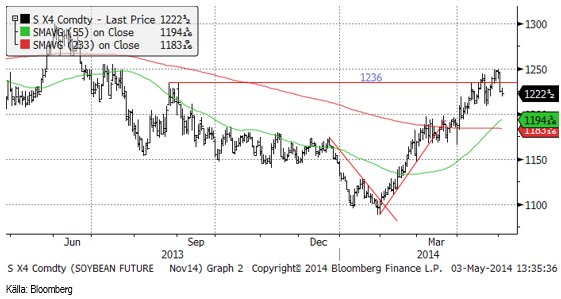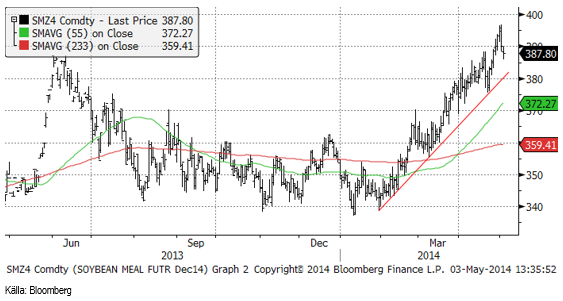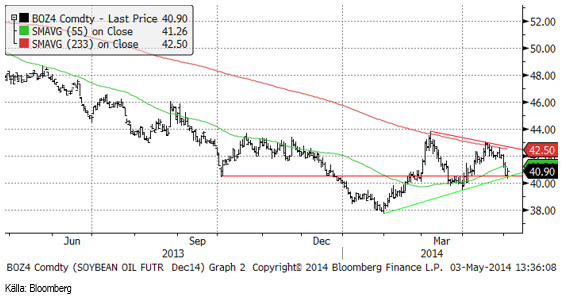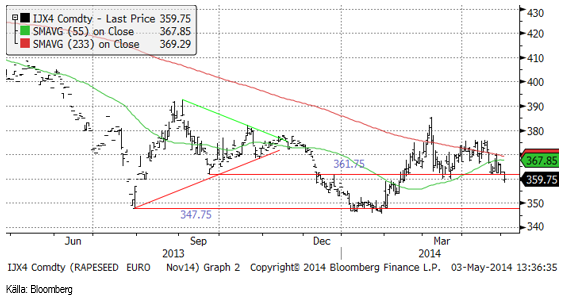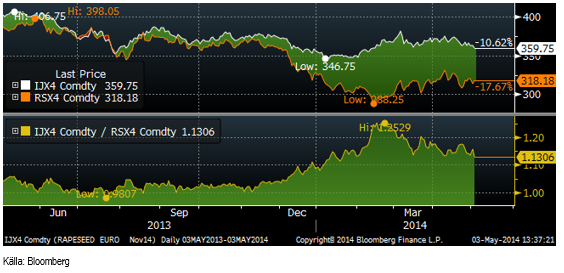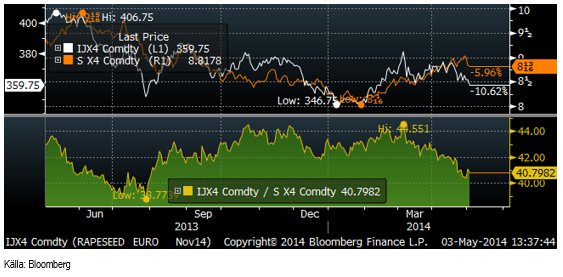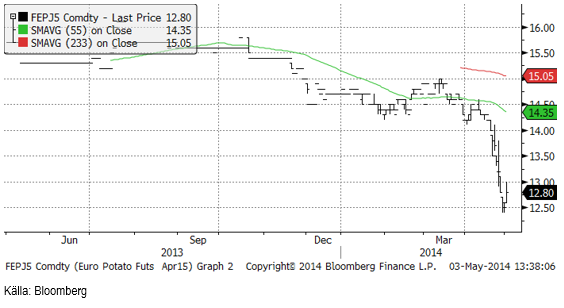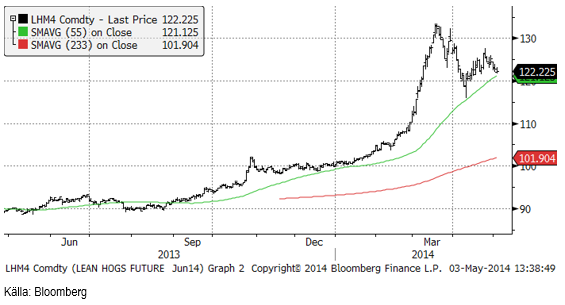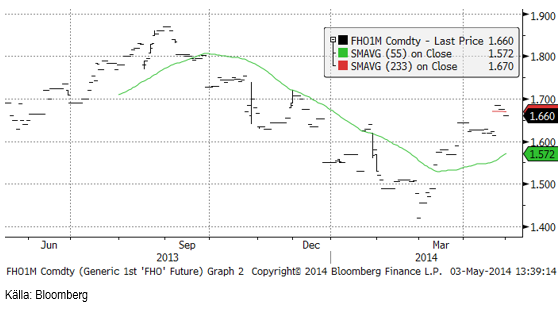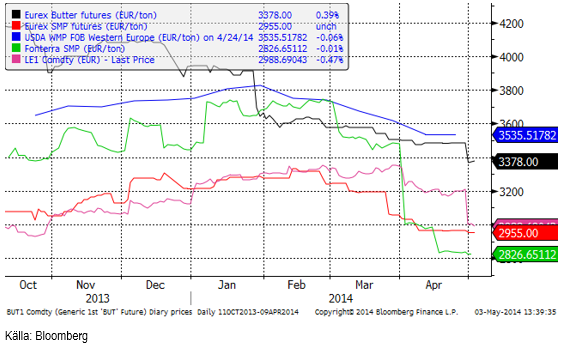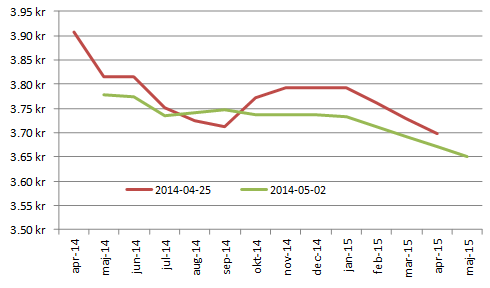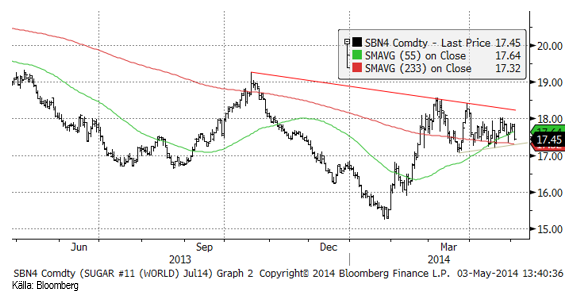Analys
SEB Jordbruksprodukter, 5 maj 2014


 Vetepriset handlades upp i fredags efter förnyad oro för situationen i Ukraina. Däremot ser väderleksprognoserna för alla veteodlande regioner utom Kansas och Texas bättre ut än på flera år. Egyptens GASC köpte också vete från Ukraina och Ryssland, där riskpremien för Ukraina var 1% på priset. Det visar att marknaden för vete fokuserar allt för mycket på Ukrainas problem (vädret och vetet är i perfekt skick) och för lite på vad som faktiskt påverkar marknadens utbud och efterfrågan – och därmed priset. Diskrepansen mellan det pris marknaden har bildat genom fel fokus å ena sidan och jordnära realiteter å den andra, gör att vi rekommenderar sälj på vete. Vädret är gynnsamt för majs också. Sådden i USA är inte sen och som utvecklingen i vädret ter sig nu, kan sådden t o m bli snabbare avklarad än normalt.
Vetepriset handlades upp i fredags efter förnyad oro för situationen i Ukraina. Däremot ser väderleksprognoserna för alla veteodlande regioner utom Kansas och Texas bättre ut än på flera år. Egyptens GASC köpte också vete från Ukraina och Ryssland, där riskpremien för Ukraina var 1% på priset. Det visar att marknaden för vete fokuserar allt för mycket på Ukrainas problem (vädret och vetet är i perfekt skick) och för lite på vad som faktiskt påverkar marknadens utbud och efterfrågan – och därmed priset. Diskrepansen mellan det pris marknaden har bildat genom fel fokus å ena sidan och jordnära realiteter å den andra, gör att vi rekommenderar sälj på vete. Vädret är gynnsamt för majs också. Sådden i USA är inte sen och som utvecklingen i vädret ter sig nu, kan sådden t o m bli snabbare avklarad än normalt.
Kinas tillväxt är på många håll i landet egentligen 4.5% i genomsnitt, dvs långt under den lagstadgade tillväxten på 7.5%. Detta visar sig i priset på t ex armeringsjärn i Kina, som är väsentligt lägre än i början av året. Efterfrågan på nya hus har mattats. Detta bör också visa sig i minskad ökning i efterfrågan på mat. Kinas annullering av kontrakt på sojabönor från USA de senaste veckorna kan vara ett tecken på det.
Odlingsväder
Samma områden i USA som sedan tidigare lider av torka, väntas enligt GFS-modellens 2-veckorprognos fortsätta att få väsentligt mindre nederbörd än normalt.
På motsvarande sätt fortsätter Europa, utom Spanien och Portugal att få mer nederbörd än normalt. Det blöta vädret har fått BASF att rapportera högre försäljning av bekämpningsmedel i vår.
Det har funnits oro på en del håll för torka i Kina, men detta borde gå över om 2-veckorsprognosen enligt nedan slår in.
Vete
Stridigheter i Ukraina mellan pro-ryska gatuprotestanter (med luftvärnsmissiler förutom den sedvanliga gatstenen) och den Ukrainska armén fick handlare att köpa upp vetepriset – igen – i fredags. Det verkar inte spela någon roll hur mycket man påpekar att Ukrainas vete till 75% är höstvete och är i utmärkt skick och bara ett par månader från skörd. Har man så här lite kunskap, förtjänar man att förlora pengar. Jag tror att vetepriset står inför en ordentlig korrektion nedåt nu. Det som spelar roll för vetemarknaden är vädret i april, maj och juni och det ser bra ut överallt i alla fyra viktiga odlingsområden på jorden, utom i Texas och Kansas.
Chicagovetet (december) har handlats upp och ligger nu strax under 750 cent.
Nedan ser vi terminskurvorna för Chicagovete och Matif i fredags och veckan innan. Som vi ser har det varit en prisuppgång generellt för terminer på Chicagovete, men inte på Matif-vete.
Andelen av USA:s vete i ”good/excellent condition” sjönk med 1% till 33% i måndagens crop condition rapport. Vetet är just nu på samma nivå som samma tid förra året.
The Wheat Quality Council i Colorado gjorde klart sin ”Hard Winter Wheat Tour” av Kansas veteområden den 1 maj. De fann efter 587 fältbesök att årets skörd kan bli 18% lägre på 261 miljoner bushels jämfört med förra årets 319 mbu. Det blir den lägsta produktionen sedan 1996 års 255 mbu.
Informa Economics estimerar i sin senaste prognos den totala veteskörden i USA till 1.496 miljarder bushels. Det är 120 miljoner bushels lägre än den förra prognosen och lägre än förra årets skörd på 1.534 miljarder bushels.
Det var frost i början av maj i Kansas med temperatur mellan 0 och -2 grader Celcius, rapporterar Martell Crop Projections. Fru Martell tillägger att ett ”vanligt” år, hade detta fått rubriker, men i år hamnar det helt i skuggan av den mycket värre torkan.
Detta har fått Hard Red Winter Wheat på Kansas City Board of Trade att dra ifrån Chicagos soft wheat, som vi ser i nedanstående graf. Det kan förefalla märkligt att det dröjde till helt nyligen, i slutet av april, för priset skillnaden att dra iväg. Crop ratings för Kansas har varit tillgängliga i ett par månader och varit i stort sett lika dåliga hela tiden.
Egypten meddelade i fredags att de liksom vid den förra ”tendern” köper vete från Ukraina. GASC köpte 55,000 ton vardera av ryskt och ukrainskt vete, som kommer att levereras under de första tio dagarna i juni. GASC fortsätter alltså att fylla på lagren, så att de räcker till ganska långt efter skörden. Detta var allt de köpte den här gången. Det ukrainska vetet var 3 dollar per ton billigare C&F jämfört med det ryska, vilket kan ge en indikation om hur liten riskpremien för Ukraina är. Alla dessa okunniga handlare som köpte upp vetepriset i fredags borde ta till sig hur liten riskpremien på den fysiska marknaden faktiskt är.
Såsom vädret utvecklar sig i de fyra stora veteproducerande områdena i världen: USA, Kina och EU och Ryssland / Ukraina, är det tydligt att det kommer att bli en stor skörd av vete i år. ”Stor” kanske rentav är ett understatement. USA får en mindre skörd, framförallt av HRW. Det är dock ännu oklart vad det myckna regnandet i Europa kommer att innebära för kvaliteten.
USDA publicerar sin WASDE på fredag klockan 18 CET, som ger årets första estimat för den kommande skörden från det amerikanska jordbruksdepartementet. Det ska bli intressant att se hur pass mycket ”bearish” information de hunnit ta med i sin rapport.
Vi går däremot redan nu över från neutral till sälj på vete.
Maltkorn
Maltkornsterminernas premie över Matif föll från 34 euro till under 30. Maltkornet för leverans i november stängde i fredags på 232 euro per ton.
Majs
Decemberkontraktet på majs föll ganska kraftigt i torsdags och fredags. Priset stängde på ett tekniskt stöd och frågan är om priset ska fortsätta falla i veckan som kommer. Det finns en hel del som talar för det, då vädret successivt väntas bli varmare och lantbrukarna i USA kan lägga i en högre växel för vårbruket. Tvärt emot situationen för vetet i Kanas och Texas, har de typiska majs-områdena fått normal till över normal nederbörd. Det har varit kallare än normalt i de norra odlingsområdena, men varmare än normalt i de södra. I genomsnitt har det hittills alltså varit ganska bra.
Den andra plantings-rapporten för året, från i måndagen 21 april visade att19% (förra veckan 6%) av majsarealen i USA var sådd per den 25 april. Kommentatorerna var snabba att påpeka att detta är sent, men det är faktiskt inte alarmerande sent. Det är snabbare än både förra året och år 2011.
Temperaturen ser ut att gå mot varmare och det är möjligt att 50 – 60% är sått om två veckor. Det är gott och väl på – eller över – normal takt.
Mot den här bakgrunden går vi över från neutral till sälj på majs, liksom för vetet.
Sojabönor
Novemberkontraktet på sojabönor nådde upp till 1250, en teknisk motståndsnivå, men vände ner därifrån och föll i torsdags och fredags ner till 1222 cent. Uppgångsfasen är antagligen avklarad och vi bör kunna få se en rekyl ner mot 1200 cent, enligt den tekniska skolans analys.
Sojamjölet, som är det som drivit priset på sojabönorna uppåt, har uppe vid den föregående toppen i maj-juni förra året. Vi har svårt att se att den här prisnivån ska bli bestående och rekommenderar sälj.
Sojaoljan föll ner till det tekniska stödet strax över 40 dollar. Tekniskt har sojaoljan bildat en ”triangelformation” och då bör man avvakta ett utbrott från den. Just nu ligger priset precis på botten av triangeln. Ett brott på nedsidan kan i första hand ta ner priset till 38 dollar. Den fundamentala information som skulle kunna ges skulden för detta är t ex om det skulle komma bekräftelse på att Ukrainas bönder valt att så solrosor i stället för majs i större utsträckning än vad marknadens aktörer (i väst) haft klart för sig.
Vi skrev förra veckan att uppgången höll på att mattas, men vi behöll neutral rekommendation. Nu tycker vi det är dags att gå över till sälj.
Raps
Novemberkontraktet på Matif bröt ett väsentligt tekniskt stöd i fredags innan marknaden stängde och det skickar en varningssignal om att priset kan falla ner till det gamla tekniska stödet vid 350 euro per ton. Det är också kontraktslägsta. Det är alltså möjligt att priset faller ännu lägre, om det vill sig illa.
Skillnaden mellan kanadensisk canola i eurotermer och Matifs rapskontrakt (båda för novemberleverans) har sedan förra veckan minskat från 15% till 13%. Jag tycker fortfarande att spreaden är värd att sälja.
Nedanför ser vi kvoten mellan rapsfrö (november) och sojabönor (november, omräknat till euro. Kvoten ligger kvar på 41, samma som förra veckan.
Jag går tillbaka till säljrekommendation på raps.
Potatis
Potatis fortsatte prisfallet från förra veckans 13.20 till 12.80 i fredags.
Gris
Juni-kontraktet på har rekylerat ner till det tekniska stödet för uppgången. Ett brott av den på nedsidan skulle kunna utlösa ett större kursfall. Inom EU har det talats om ett importförbud för amerikanskt fläskkött med hänvisning till risken för spridning av PED-viruset. Det är ett argument som passar bra i den pressade europeiska grisnäringen.
Spotkontraktet på EUREX Hogs backade i veckan med 2 eurocent per Kg till 1.66 euro per Kg.
Mjölk
I onsdags publicerade Eurex de senaste indexnivåerna för Eurex smör och Eurex SMP index. Där noterades ett ganska stort prisfall i mjölk, från 3500 euro per ton till 3378 euro per ton. Även SMP-indexet kom in lägre, men bara med en hårsmån. Terminsmarknaden var kraftigt lägre i USA (beroende på terminsförfall), liksom på Eurex, beroende också på att april månads terminer förföll i tisdags för avräkning mot indexen som publicerades i onsdags. Det är ju alltid terminsförfall tisdagen innan den sista onsdagen varje månad.
Terminspriserna är lägre, framförallt för att april månads terminskontrakt förföll. Terminsmarknaden förutspår ytterligare prisnedgångar fram till sommaren och därefter en stabilisering.
Detta innebär att genomsnittliga priset för ett Kilo mjölkråvara basis Eurex SMP och smörterminer för perioden maj 2014 till och med maj 2015 är 3.73 kronor. Det är en något lägre än förra veckan då det april – april låg på 3.78 kr.
SEB förbättrar börsens köpkurs med 1% (så länge marknaden är på introduktionsstadium och i behov av stöd enligt vår uppfattning). Detta innebär att SEB betalar i genomsnitt 3.76 öre per Kilo per månad maj 2014 – maj 2015.
Socker
Priset på socker ligger kvar i konsolidering mellan 17 och 18.50 cent. Det är ett prisintervall som etablerades i början av förra månaden. I fredags föll priset ganska kraftigt, men fortfarande höll sig priset inom intervallet.
Vi behåller neutral vy på socker.
[box]SEB Veckobrev Jordbruksprodukter är producerat av SEB Commodities Sales desk och publiceras i samarbete och med tillstånd på Råvarumarknaden.se[/box]
Detta marknadsföringsmaterial, framtaget av SEB’s Commodities Sales desk, har upprättats enbart i informationssyfte.
Även om innehållet är baserat på källor som SEB bedömt som tillförlitliga ansvarar SEB inte för fel eller brister i informationen. Den utgör inte oberoende, objektiv investeringsanalys och skyddas därför inte av de bestämmelser som SEB har infört för att förebygga potentiella intressekonflikter. Yttranden från SEB’s Commodities Sales desk kan vara oförenliga med tidigare publicerat material från SEB, då den senare hänvisas uppmanas du att läsa den fullständiga rapporten innan någon åtgärd vidtas.
Dokumentationen utgör inte någon investeringsrådgivning och tillhandahålls till dig utan hänsyn till dina investeringsmål. Du uppmanas att självständigt bedöma och komplettera uppgifterna i denna dokumentation och att basera dina investeringsbeslut på material som bedöms erforderligt. Alla framåtblickande uttalanden, åsikter och förväntningar är föremål för risker, osäkerheter och andra faktorer och kan orsaka att det faktiska resultatet avviker väsentligt från det förväntade. Historisk avkastning är ingen garanti för framtida resultat. Detta dokument utgör inte ett erbjudande att teckna några värdepapper eller andra finansiella instrument. SEB svarar inte för förlust eller skada – direkt eller indirekt, eller av vad slag det vara må – som kan uppkomma till följd av användandet av detta material eller dess innehåll.
Observera att det kan förekomma att SEB, dess ledamöter, dess anställda eller dess moder- och/eller dotterbolag vid olika tillfällen innehar, har innehaft eller kommer att inneha aktier, positioner, rådgivningsuppdrag i samband med corporate finance-transaktioner, investment- eller merchantbankinguppdrag och/eller lån i de bolag/finansiella instrument som nämns i materialet.
Materialet är avsett för mottagaren, all spridning, distribuering mångfaldigande eller annan användning av detta meddelande får inte ske utan SEB:s medgivande. Oaktat detta får SEB tillåta omfördelning av materialet till utvald tredje part i enlighet med gällande avtal. Materialet får inte spridas till fysiska eller juridiska personer som är medborgare eller har hemvist i ett land där sådan spridning är otillåten enligt tillämplig lag eller annan bestämmelse.
Skandinaviska Enskilda Banken AB (publ) är ett [publikt] aktiebolag och står under tillsyn av Finansinspektionen samt de lokala finansiella tillsynsmyndigheter i varje jurisdiktionen där SEB har filial eller dotterbolag.
Analys
Tightening fundamentals – bullish inventories from DOE

The latest weekly report from the US DOE showed a substantial drawdown across key petroleum categories, adding more upside potential to the fundamental picture.

Commercial crude inventories (excl. SPR) fell by 5.8 million barrels, bringing total inventories down to 415.1 million barrels. Now sitting 11% below the five-year seasonal norm and placed in the lowest 2015-2022 range (see picture below).
Product inventories also tightened further last week. Gasoline inventories declined by 2.1 million barrels, with reductions seen in both finished gasoline and blending components. Current gasoline levels are about 3% below the five-year average for this time of year.
Among products, the most notable move came in diesel, where inventories dropped by almost 4.1 million barrels, deepening the deficit to around 20% below seasonal norms – continuing to underscore the persistent supply tightness in diesel markets.
The only area of inventory growth was in propane/propylene, which posted a significant 5.1-million-barrel build and now stands 9% above the five-year average.
Total commercial petroleum inventories (crude plus refined products) declined by 4.2 million barrels on the week, reinforcing the overall tightening of US crude and products.


Analys
Bombs to ”ceasefire” in hours – Brent below $70

A classic case of “buy the rumor, sell the news” played out in oil markets, as Brent crude has dropped sharply – down nearly USD 10 per barrel since yesterday evening – following Iran’s retaliatory strike on a U.S. air base in Qatar. The immediate reaction was: “That was it?” The strike followed a carefully calibrated, non-escalatory playbook, avoiding direct threats to energy infrastructure or disruption of shipping through the Strait of Hormuz – thus calming worst-case fears.

After Monday morning’s sharp spike to USD 81.4 per barrel, triggered by the U.S. bombing of Iranian nuclear facilities, oil prices drifted sideways in anticipation of a potential Iranian response. That response came with advance warning and caused limited physical damage. Early this morning, both the U.S. President and Iranian state media announced a ceasefire, effectively placing a lid on the immediate conflict risk – at least for now.
As a result, Brent crude has now fallen by a total of USD 12 from Monday’s peak, currently trading around USD 69 per barrel.
Looking beyond geopolitics, the market will now shift its focus to the upcoming OPEC+ meeting in early July. Saudi Arabia’s decision to increase output earlier this year – despite falling prices – has drawn renewed attention considering recent developments. Some suggest this was a response to U.S. pressure to offset potential Iranian supply losses.
However, consensus is that the move was driven more by internal OPEC+ dynamics. After years of curbing production to support prices, Riyadh had grown frustrated with quota-busting by several members (notably Kazakhstan). With Saudi Arabia cutting up to 2 million barrels per day – roughly 2% of global supply – returns were diminishing, and the risk of losing market share was rising. The production increase is widely seen as an effort to reassert leadership and restore discipline within the group.
That said, the FT recently stated that, the Saudis remain wary of past missteps. In 2018, Riyadh ramped up output at Trump’s request ahead of Iran sanctions, only to see prices collapse when the U.S. granted broad waivers – triggering oversupply. Officials have reportedly made it clear they don’t intend to repeat that mistake.
The recent visit by President Trump to Saudi Arabia, which included agreements on AI, defense, and nuclear cooperation, suggests a broader strategic alignment. This has fueled speculation about a quiet “pump-for-politics” deal behind recent production moves.
Looking ahead, oil prices have now retraced the entire rally sparked by the June 13 Israel–Iran escalation. This retreat provides more political and policy space for both the U.S. and Saudi Arabia. Specifically, it makes it easier for Riyadh to scale back its three recent production hikes of 411,000 barrels each, potentially returning to more moderate increases of 137,000 barrels for August and September.
In short: with no major loss of Iranian supply to the market, OPEC+ – led by Saudi Arabia – no longer needs to compensate for a disruption that hasn’t materialized, especially not to please the U.S. at the cost of its own market strategy. As the Saudis themselves have signaled, they are unlikely to repeat previous mistakes.
Conclusion: With Brent now in the high USD 60s, buying oil looks fundamentally justified. The geopolitical premium has deflated, but tensions between Israel and Iran remain unresolved – and the risk of missteps and renewed escalation still lingers. In fact, even this morning, reports have emerged of renewed missile fire despite the declared “truce.” The path forward may be calmer – but it is far from stable.
Analys
A muted price reaction. Market looks relaxed, but it is still on edge waiting for what Iran will do

Brent crossed the 80-line this morning but quickly fell back assigning limited probability for Iran choosing to close the Strait of Hormuz. Brent traded in a range of USD 70.56 – 79.04/b last week as the market fluctuated between ”Iran wants a deal” and ”US is about to attack Iran”. At the end of the week though, Donald Trump managed to convince markets (and probably also Iran) that he would make a decision within two weeks. I.e. no imminent attack. Previously when when he has talked about ”making a decision within two weeks” he has often ended up doing nothing in the end. The oil market relaxed as a result and the week ended at USD 77.01/b which is just USD 6/b above the year to date average of USD 71/b.

Brent jumped to USD 81.4/b this morning, the highest since mid-January, but then quickly fell back to a current price of USD 78.2/b which is only up 1.5% versus the close on Friday. As such the market is pricing a fairly low probability that Iran will actually close the Strait of Hormuz. Probably because it will hurt Iranian oil exports as well as the global oil market.
It was however all smoke and mirrors. Deception. The US attacked Iran on Saturday. The attack involved 125 warplanes, submarines and surface warships and 14 bunker buster bombs were dropped on Iranian nuclear sites including Fordow, Natanz and Isfahan. In response the Iranian Parliament voted in support of closing the Strait of Hormuz where some 17 mb of crude and products is transported to the global market every day plus significant volumes of LNG. This is however merely an advise to the Supreme leader Ayatollah Ali Khamenei and the Supreme National Security Council which sits with the final and actual decision.
No supply of oil is lost yet. It is about the risk of Iran closing the Strait of Hormuz or not. So far not a single drop of oil supply has been lost to the global market. The price at the moment is all about the assessed risk of loss of supply. Will Iran choose to choke of the Strait of Hormuz or not? That is the big question. It would be painful for US consumers, for Donald Trump’s voter base, for the global economy but also for Iran and its population which relies on oil exports and income from selling oil out of that Strait as well. As such it is not a no-brainer choice for Iran to close the Strait for oil exports. And looking at the il price this morning it is clear that the oil market doesn’t assign a very high probability of it happening. It is however probably well within the capability of Iran to close the Strait off with rockets, mines, air-drones and possibly sea-drones. Just look at how Ukraine has been able to control and damage the Russian Black Sea fleet.
What to do about the highly enriched uranium which has gone missing? While the US and Israel can celebrate their destruction of Iranian nuclear facilities they are also scratching their heads over what to do with the lost Iranian nuclear material. Iran had 408 kg of highly enriched uranium (IAEA). Almost weapons grade. Enough for some 10 nuclear warheads. It seems to have been transported out of Fordow before the attack this weekend.
The market is still on edge. USD 80-something/b seems sensible while we wait. The oil market reaction to this weekend’s events is very muted so far. The market is still on edge awaiting what Iran will do. Because Iran will do something. But what and when? An oil price of 80-something seems like a sensible level until something do happen.
-

 Nyheter4 veckor sedan
Nyheter4 veckor sedanUppgången i oljepriset planade ut under helgen
-

 Nyheter3 veckor sedan
Nyheter3 veckor sedanMahvie Minerals växlar spår – satsar fullt ut på guld
-

 Nyheter4 veckor sedan
Nyheter4 veckor sedanLåga elpriser i sommar – men mellersta Sverige får en ökning
-

 Nyheter2 veckor sedan
Nyheter2 veckor sedanOljan, guldet och marknadens oroande tystnad
-

 Analys4 veckor sedan
Analys4 veckor sedanVery relaxed at USD 75/b. Risk barometer will likely fluctuate to higher levels with Brent into the 80ies or higher coming 2-3 weeks
-

 Nyheter2 veckor sedan
Nyheter2 veckor sedanJonas Lindvall är tillbaka med ett nytt oljebolag, Perthro, som ska börsnoteras
-

 Analys3 veckor sedan
Analys3 veckor sedanA muted price reaction. Market looks relaxed, but it is still on edge waiting for what Iran will do
-

 Nyheter2 veckor sedan
Nyheter2 veckor sedanDomstolen ger klartecken till Lappland Guldprospektering


